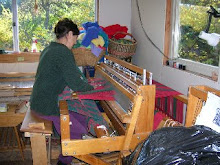 When it goes down to 10 degrees F this early in the season it is hard on the garden. Not only is that colder than we usually get, but the plants haven't had time to really adjust to winter. The above is our chard patch. Chard is only marginally hardy at those temperatures. Some of these plants will survive and start regrowing but not for quite a while. We will save seed from any that do survive and thus increase the hardiness of our own home grown strain of chard.
When it goes down to 10 degrees F this early in the season it is hard on the garden. Not only is that colder than we usually get, but the plants haven't had time to really adjust to winter. The above is our chard patch. Chard is only marginally hardy at those temperatures. Some of these plants will survive and start regrowing but not for quite a while. We will save seed from any that do survive and thus increase the hardiness of our own home grown strain of chard. One reason for planting several varieties of a plant (other than just for the fun of the different colors and leaf types) is that that increases the chance of one or more varieties handing whatever stress the year throws at the garden. In this case our Savoy kale, came through the storm virtually untouched. In front of it is one called Russian Hunger gap which, in spite of its name, did not come through well. Time will tell if the roots are dead or not.
One reason for planting several varieties of a plant (other than just for the fun of the different colors and leaf types) is that that increases the chance of one or more varieties handing whatever stress the year throws at the garden. In this case our Savoy kale, came through the storm virtually untouched. In front of it is one called Russian Hunger gap which, in spite of its name, did not come through well. Time will tell if the roots are dead or not. Most of the cabbage also survived as did the overwintering purple sprouting broccoli, the Brussels sprouts and all the collards. the Romanesco broccoli didn't nor did the early fall cauliflower. The overwintering varieties of cauliflower look better. They have lost outer leaves and so will probably make smaller heads but they look like they will make it.
Most of the cabbage also survived as did the overwintering purple sprouting broccoli, the Brussels sprouts and all the collards. the Romanesco broccoli didn't nor did the early fall cauliflower. The overwintering varieties of cauliflower look better. They have lost outer leaves and so will probably make smaller heads but they look like they will make it. The carrots were under enough snow to survive and the potatoes were covered with a mulch of maple leaves and are fine. The big Three Root Grex beets originally looked like they had gotten frozen but after a few days look perfectly normal.
The carrots were under enough snow to survive and the potatoes were covered with a mulch of maple leaves and are fine. The big Three Root Grex beets originally looked like they had gotten frozen but after a few days look perfectly normal.So we take note for future winter gardens, harvest what we can for market this weekend and wonder what else winter will throw at us this year.


No comments:
Post a Comment